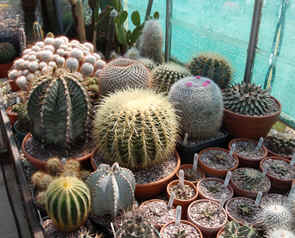Contents
of the Winter 2013 Northants News
|
Fenland
Wanderings
Roland
Tebbenham |
Photographs
by Lynne and Roland Tebbenham
|

|
Four
Cambridge Branch members’ collections were open on Sunday July 7th and
the weather promised to be sunny and very warm. Route planning was simple;
head for Ely and then work back south-west via Great Shelford making a
round trip of roughly 165 miles. Your Editor had sent his apologies owing
to other family affairs; so I was assigned to record the event and weave
these few words for the magazine.
I
do like the annual open days since they offer opportunities to snoop
around other folks’ greenhouses, see their gardens, cross tracks with
old friends as well as meeting new ones. Well this occasion did not
disappoint with four very different C&S collections and many other
plants and wildlife to appreciate as well as lots of chatter.
|
|

|

|
Lynne
and I started at noon at David Latham’s greenhouse in Ely. He grows a
mixed collection of cacti and other succulents built up over thirty years.
The main house is a 12' X 8' containing mostly cacti with some nice mature
Astrophytums, Mammillarias, Rebutias, Echinocacti, Cerei and Thelocacti.
The older specimens are complemented by many seed-grown plants. A second,
smaller greenhouse is kept warmer to grow other succulents and more tender
cacti such as Melocacti and some Cerei.
|
|
Above:
David
Latham in his greenhouse with his plants.
|
There
is also a developing collection of neater, smaller Agaves. We also enjoyed
seeing David’s garden, especially his “wet, shady, clayey border” with
contrasting perennials including three variegated Brunnera
cultivars, Primula
vialii and the
striking, rather well-named Podophyllum
emodyi
‘Spotty Dotty’.
|

|

|

|
|
Interesting
plants in David Latham’s garden noted by Roland |
|
Podophyllum
emodyi ‘Spotty Dotty’.
|
Primula
vialii,
an unusual looking species which likes
a damp situation. |
Brunnera
’Jack Frost’ It
has small blue flowers in Spring rather similar to the Forget-me-not.
|
We
left David and headed twelve miles south to Cottenham to visit Trevor Jeeps.
After some lunch in the welcome shade of his gazebo we were greeted by a sea of
mesembs in the first section of a 24’ X 8’ greenhouse. The other section
featured nice Echeverias, Haworthias, Gasterias and some larger mature Cacti.
Trevor has grown many of his plants from BCSS and MSG seed; and evidence of his
success was obvious. We saw plants at various stages looking really healthy and
there were many plants for sale. Yes, you guessed it: I found a nice Gibbaeum
and a couple of Lithops to buy.
|

|
Left:
Well grown cacti in Trevor Jeeps’ collection.
Right:
A
‘sea
of Mesembs’ and Lithops seedlings as part of Trevor Jeep’s collection.
|

|

|
Our
third venue was a few miles further south in Milton on the outskirts of
Cambridge, where we met Tina and Hugh outside; they were travelling in the
opposite direction. Clarke Brunt has mainly cacti in a 20’ X 8’ greenhouse.
He focuses his efforts on propagation and seed raising rather than growing large
specimen plants. There are also some other succulents, notably a selection of Aloe
polyphylla plants
ranging from 10cm to 50cm pots, one of the largest being in flower.
Clarke’s
garden featured a pond, beehive, carnivorous plants, bulbs and many containers.
We also viewed the swift’s nest (in one of the six nest-boxes) via the camera
and monitor. Fortunately I had taken a box and packing with me; a Scadoxus
(South African bulb) and a Bromeliad from collected seed joined the three small
mesembs to travel back to Towcester.
|

|
 |

|
|
Above:
Sarracenia
growing in Clark Brunt’s garden
|
Above
and right: Aloe
polyphylla,
a flowering plant in Clark Brunt’s collection.
|
Our
final stop was with Paul Hoxey in Great Shelford. Paul has been growing cacti
since the 1980s and recently celebrated 25 years of BCSS membership. He has
three greenhouses cleverly amalgamated into one structure, which is filled with
cacti with a few other succulents, cycads and bromeliads. Paul uses very little
heat in winter, keeping a small ‘inner sanctum’ warmer for selected Cerei,
and the majority of his very large collection stay dry and just frost-free.
|

|
 |

|
|
Above:
A general view in Paul Hoxey’s collection.
|
Above
Many
large Eulychnias and
right: Espostoas
in Paul Hoxey’s collection
|
Paul’s
collection is split evenly between North and South American species and is
dominated by plants raised from seed collected in Chile, Peru and Mexico during
the past twenty years. He is removing undocumented plants and the result is a
sea of orange labels denoting his own collected seed-grown material. I have
never seen so many Eulychnias in one place!
|

|
 |
The
pictures show some of my favourite plants – Copiapoa – and nice groups
of Ariocarpus, Astrophytum and Espostoa. After more refreshments and a
chat with Paul and David & Gill Wilson we finally dragged ourselves
away well after the advertised closing time of 5pm. Overall it was an
excellent day and I offer my thanks to the Cambridge Branch members who
made us and our fellow travellers so very welcome. I look forward to the
next one…
Roland
|
|
Astrophytum myriostigma flower in Paul’s collection.
|
Paul’s
superb seed raised Ariocarpus. |
Ed:
Thanks Roland, I always enjoy a good travelogue around cactus and
succulent country, even when they are Cambridgeshire cultivated. Sounds like a
great day and it is just unfortunate that family celebrations prevented my
attendance. Open days are definitely one of my favourite ways of spending a day
(and acquiring some more plants and cuttings) and we should be grateful that
growers are prepared to make the effort.

















